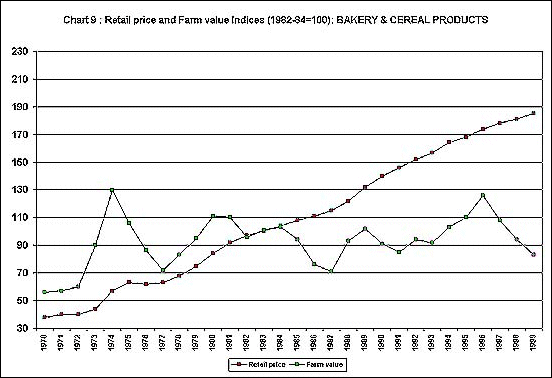|
This is especially
evident in the case of fats and oilseeds (Chart 5),
where the extent of processing is largely unchanged
over the period. Farm values for oilseeds show a volatile,
fluctuating pattern similar to that on foodgrains and
a number of other agricultural products. Furthermore,
these are cyclical patterns around a stagnant secular
trend. However, retail prices of fats and oilseeds show
a rising trend, and by the 1990s, this trend shows rates
of increase which are not only smoother but substantially
more than the change in farm values. And the same holds
for bakery and cereal products.

Chart
8 >> Click
to Enlarge

Chart
9 >> Click
to Enlarge
This is not something that can be explained only or
even dominantly by changes in levels of processing,
changed consumer tastes and preferences, etc. Clearly,
something else has been going on. And that other process,
which has operated to increase the share of value accruing
to the distribution, is the increasing corporatisation
of food production and concentration of agro-industries,
especially in the US but also in the rest of the world.
The process of concentration of industry is one that
has affected virtually all productive sectors in the
world economy. It is just as evident in the food processing
and marketing sector, which was already a more concentrated
sector at the beginning of the decade of the 1990s.
As a consequence, a handful of large companies now handle,
control or are involved in some way in almost all aspects
of production and distribution of food. In the US, where
the process of corporatisation of agriculture is not
only well advanced but has accelerated over the 1990s.
Consider the companies that now control certain important
food sectors in the US economy :
-
in grain trade and processing: Cargill (which
swallowed Continental, the second-largest grain trader), Archer Daniels
Midland (ADM), ConAgra.
-
in beef packing and distribution : IBP, ConAgra,
Cargill (as owner of Excel).
-
in cattle feed : Cargill, Cactus Feeders, ConAgra.
-
in pork processing : Smithfield, IBP,
ConAgra, Cargill.
-
in hog raising : Smithfield (the largest pork
processor has bought the largest and second-largest hog producers,
Murphy Family Farms and Carroll's Foods), Cargill, Seaboard.
-
in biotech and seeds: Monsanto, Cargill, DuPont/Pioneer, Novartis, Aventis.
-
in supermarkets: Kroger, Albertson's, Safeway, AHOLD (Giant), Winn-Dixie,
Wal-Mart.
The repetition of a few names confirms the point that,
as in some other interconnected industries, a few diversified firms
are positioned on many sides of the market at once. Increasingly, the
process of mergers and acquisitions are connected through a complicated
system of "strategic alliances" and cross-ownership.
Thus, Smithfield, the world's largest hog producer
and pork processor, recently bought a 6.3 percent stake in its rival
company IBP, the second-largest pork processor. ADM already owned a
12.2 percent share of IBP. This kind of cross-ownership is likely to
continue, as IBP itself is now to be acquired in a friendly takeover
by the Wall Street brokerage firm Donaldson, Lufkin & Jenrette (which
was recently bought by Credit Suisse First Boston). Cargill and Monsanto
have a complex and elaborate web of joint ventures that runs from fertiliser
and seeds to grain and raising cattle, hogs, turkeys and chickens, then
on to the butcheries and packing plants.
|

